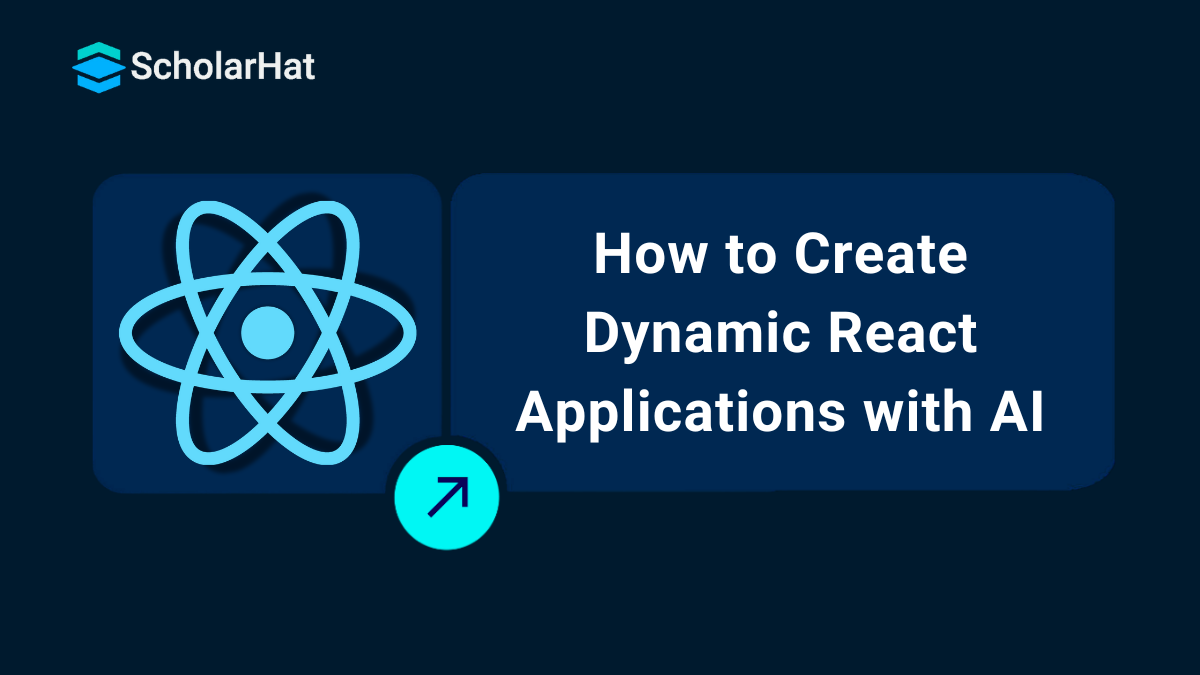26
DecHow to Create Dynamic React Applications with AI
ReactJS and AI-powered intersection made web development more advanced. Because of this, developers can create complex and dynamic user interfaces which is adaptable as well as responsible.
In this React Tutorial, we will explore more about React and Artificial Intelligence. Today, as artificial intelligence (AI) continues to grow fast, integrating it into web development offers exciting opportunities to create smarter and more personalized user experiences. Al-powered web components use machine learning algorithms and natural language. Let's see the challenges, and opportunities to integrate AI and ReactJS to build the next generation of intelligent web applications. React.js is the #1 framework for modern web apps. Don’t stay stuck with outdated skills—Enroll now in our Free React JS Certification and level up!
Advancement of Web Development
- The Development of online applications has changed significantly over the last years, It's changed from static HTML sites to dynamic ones.
- The developing requirement for more responsive and dynamic web experiences has been growing because of this advancement.
- This change was made conceivable by JavaScript.
- The complexity of online applications made it more difficult to control the state and behavior of UI elements, though.
- As a result, frontend frameworks and libraries such as ReactJS became popular and brought with them new views for creating user interfaces for websites.
- In React JS, The introduction of a component-based design that assures reusability, modularity, and maintainability.
What is ReactJS?
- Facebook launched ReactJS and it has quickly become a popular library/framework for writing UI software.
- React JS ( or "React for short") makes software development easier and more efficient by adopting the virtual DOM approach to writing software that can interact with the actual DOM.
- In React JS, a representation of the actual DOM is kept in memory that closely mimics the structure and actions of the real DOM, utilizing as little updating on the real DOM as possible to keep the software running smoothly, maintaining good responsiveness and a fast UI.
- React JS has a conceptual mechanism that combines the relative ease of programming in a low-level language such as Javascript with the benefits of modern software development tools and techniques inherited from the object-oriented programming approach.
- UI software is written using a component-based approach, where larger UI components are built from smaller, simpler reusable components.
- In most React websites, the overall application is represented by the root component, housing all the other components that act as its children, which in turn, have their children.
- This tree structure forms an ongoing, dynamic tree that the React JS runs on, selecting, updating, and keeping track of its components and the data contained within each of them.
- When part of the UI is modified, React JS updates that particular application component and everything that depends on it as well, synchronizing as per the new requirement without the need for developers to specifically instruct it.

Understanding AI
- Artificial intelligence (AI) is used in web development in many ways. It is used in recommender systems, NLP chats, and computer vision for image recognition.
- Recommender systems allow developers to personalize websites by learning the spending history of users and recommending products that suit them better.
- It improves engagement and retention on websites. Users can interact more naturally in web applications using chatbots and conversational interfaces.
- They are often built on natural language processing principles.
- Image recognition through computer vision allows users to search via images. It makes the user experience more natural in the use of applications, such as online shopping and content-rich channels with images.
- Artificial intelligence is increasing its impact on web development.
- Better, smarter, and more personalized user interfaces will be seen in the future of the web.
Challenges in Integrating AI with ReactJS
- Some of the challenges developers face in melding AI with ReactJS include but also, the integration of AI technologies into ReactJS can improve web applications.
- A major issue is how to incorporate an AI model or algorithm into a ReactJS component without sacrificing performance and scalability.
- One may be put off by the task of managing big data sets alongside ensuring that AI components are connected efficiently to UIs in ReactJS.
- Not only this, deploying and updating AI models inside production environments requires careful thinking about versioning, monitoring, and maintenance.
- Despite these difficulties, it would be possible to use AI with ReactJS more effectively to improve customer engagement; increase conversion rates; as well as optimize content delivery.
- It is through using things like personalized suggestions based on users' behavior, predictive analytics, or intelligent chatbots powered by artificial intelligence (AI) that web developers can design more immersive internet interactions that are meaningful for end-users.
Integration of AI with ReactJS
Integrating AI with ReactJS poses both challenges and opportunities for web developers. One of the challenges is seamlessly incorporating AI models or algorithms into ReactJS components without compromising performance and scalability. Developers must carefully manage large datasets and ensure efficient connections between AI components and ReactJS UIs. Deploying and updating AI models in production environments also requires strategic planning for versioning, monitoring, and maintenance. However, the integration of AI technologies into ReactJS offers significant benefits for web applications. By leveraging AI, developers can enhance customer engagement, increase conversion rates, and optimize content delivery. Personalized suggestions based on user behavior, predictive analytics, and intelligent chatbots powered by AI can create immersive internet interactions that resonate with end-users.
BEST PRACTICES FOR BUILDING AI-POWERED WEB COMPONENTS WITH REACTJS
- For anyone to create ReactJS-based web components with AI, they must be well-versed in the core principles that guide this process.
- Such best practices include first identifying which tasks can be enhanced through the application of artificial intelligence, e.g., personalized recommendations and natural language understanding.
- Once these use cases are set in stone, programmers will select the most appropriate ReactJS-compliant AI libraries and APIs.
- Let's say you want to build machine learning models directly on the browser then TensorFlow.js is a good choice while others like Spacy or Dialogflow will facilitate NLP-based chatbot development.
- It's important to note that AI-powered components should not only scale but also perform optimally, thus developers should optimize their data fetching and processing techniques to reduce delays between requests. Furthermore, if a developer wants his code to be as clean and maintainable as possible he should ensure following some of the ReactJS best practices including component composition as well as state management and lifecycle methods among others.
ADVANCED AI TECHNIQUES FOR REACT
In addition to traditional machine learning and NLP techniques, advanced AI methods can be leveraged in ReactJS applications for enhanced functionality and user experiences:
1. Deep Learning
Deep learning algorithms, such as deep neural networks (DNNs) and convolutional neural networks (CNNs), can be integrated into ReactJS to handle complex tasks like image recognition, natural language understanding, and sentiment analysis. These techniques enable more accurate and nuanced predictions, leading to improved user interactions and recommendations.
2. Reinforcement Learning
Integrating reinforcement learning algorithms into ReactJS components can create interactive and adaptive user interfaces. For example, chatbots powered by reinforcement learning can learn from user interactions over time, improving their responses and suggestions based on user feedback.
3. Generative Models
Generative models like Generative Adversarial Networks (GANs) and Variational Autoencoders (VAES) can be used in ReactJS applications to generate realistic content, such as images, text, or music. This can be particularly useful for creating dynamic and personalized content experiences for users.
ENSURING SCALABILITY AND PERFORMANCE
When integrating AI with ReactJS, developers must also consider scalability and performance aspects to ensure smooth and efficient functioning of web components:
1. Optimized Data Handling
Implement efficient data fetching and processing mechanisms to handle large datasets and real-time interactions without compromising performance. Use techniques like data caching, lazy loading, and asynchronous processing to minimize latency and improve responsiveness.
2. Server-Side Rendering (SSR)
Utilize server-side rendering techniques in ReactJS applications to improve initial load times and SEO performance. SSR can help in pre-rendering Al-powered content or components, reducing client-side processing, and enhancing scalability for high-traffic applications.
Conclusion:
In conclusion, the combination of AI and ReactJS opens up exciting new possibilities for web developers enabling them to produce more customized intelligent and adaptive online experiences. Developers can create web applications that predict user needs optimize workflows and provide significant value by utilizing the advantages of ReactJS component-based architecture and the power of AI technologies like machine learning and natural language processing.
The average React.js developer earns ₹15–25 LPA, but seniors earn more. Don’t wait—Enroll in our Reactjs Certification Course and unlock top-tier roles!
Take our React skill challenge to evaluate yourself!

In less than 5 minutes, with our skill challenge, you can identify your knowledge gaps and strengths in a given skill.











